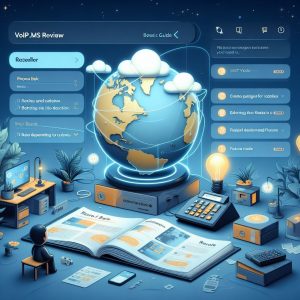I. Introduction
Definition of VoIP Phone Numbers
A VoIP phone number is a digital phone number assigned to a user or business to make and receive calls over a Voice over Internet Protocol (VoIP) phone system. Unlike a regular landline phone number that connects to the analog Public Switched Telephone Network (PSTN), a VoIP number facilitates phone service over a broadband internet connection.
VoIP numbers work by converting a user’s voice into digital packets that are transmitted over the internet, similarly to how data travels over a network. These packets are then converted back into voice signals at the destination phone to enable a two-way call conversation.
VoIP numbers can be purchased from a VoIP provider and are assigned to a user account within the provider’s phone system infrastructure. The user can then make and receive calls to external PSTN numbers or internal extensions using the assigned VoIP number.
Importance of VoIP Phone Numbers for Businesses
VoIP phone numbers are important for modern businesses because they enable moving business phone systems to the cloud and gaining advanced capabilities of VoIP technology. Key benefits include:
- Cost savings – VoIP eliminates per minute long distance charges incurred with traditional landlines. Monthly service fees are also lower.
- Flexibility – Numbers can be instantly added, changed or reassigned as business needs evolve.
- Mobility – Calls to VoIP numbers can ring any device such as cell phones or laptops.
- Productivity – Features like auto attendants, voicemail to email, and call analytics improve operations.
- Scalability – Easily add numbers and inbound call capacity as a business grows.
- Reliability – VoIP providers deliver excellent uptime and redundancy.
VoIP phone numbers facilitate modern cloud-based phone systems that drive efficiency and flexibility gains.

II. Types of VoIP Phone Numbers
There are several types of VoIP phone numbers that businesses can utilize:
Local Phone Numbers
Local phone numbers have an area code and prefix matching a specific geographic region. Local VoIP numbers allow businesses to establish service in regions where they have a physical presence with an office, retail location, or employee base.
A local VoIP number enables customers to contact the business at a familiar local area code instead of a toll-free number. Local numbers builds trust and gives the impression of proximate customer service.
Toll-Free Numbers
Toll-free numbers, such as 800 or 888 numbers, enable customers to call a business free of charge. The business owner pays for the cost of inbound toll-free calls. Toll-free numbers make it easy for customers to reach a company without incurring long distance fees.
VoIP providers can supply toll-free numbers alongside local numbers. Toll-free numbers are ideal for sales, support, reservations or other customer-facing functions.
Virtual Phone Numbers
Virtual phone numbers are not associated with a specific geographic area. A virtual number can have any area code and prefix combination. Virtual numbers provide maximum flexibility when choosing a number for branding purposes.
Businesses use virtual VoIP numbers as corporate main numbers, department numbers, or extensions. Callers are unaware a number is virtual.
International Phone Numbers
VoIP providers can assign phone numbers from many countries around the world. This enables businesses to establish a local presence at international branch offices or serve foreign customers at lower cost.
International numbers help global businesses improve trust and brand recall in foreign markets. Customers abroad can make local calls.
III. How VoIP Phone Numbers Work
VoIP leverages broadband internet connections to transmit calls instead of traditional telephone lines. Here is an overview of how VoIP numbers convert calls and route over the internet:
Conversion of Analog Phone Audio into Digital Data Packets
A microphone on VoIP hardware or software converts inbound voice into digital signals. Voice data is compressed into packets using audio codecs like G.711, G.729 or Opus. Packets receive IP address headers to traverse the internet.
Outbound voice is reconstructed from packets at the destination into analog audio signals that regular phones can interpret. This encoding and decoding happens in near real-time to minimize latency.
Use of Tier-1 Carrier Data Networks for High-Quality Audio
VoIP providers partner with major Tier 1 internet and broadband carriers to transmit call data over fast, reliable networks. Quality of Service controls prioritize voice packets over other traffic.
Dedicated voice packet routes avoid public internet congestion. Fiber optic and SD-WAN underlay reliable transport between VoIP gateways globally for crystal clear call quality.
Additional Features of VoIP Phone Systems
In addition to converting voice to IP packets, VoIP phone systems provide a full-featured business phone experience:
- Auto attendants, IVRs and virtual receptionist capabilities
- Conference calling bringing multiple callers onto one line
- Video calling with modern desk phones and mobile apps
- CRM integrations that display customer records on screen when a known number calls
- Visual voicemail allowing users to select and listen to messages in any order
- Call analytics to monitor call volumes, wait times, abandon rates and other KPIs
- Call recording for quality assurance, training or compliance purposes

IV. Numbering for VoIP Services
VoIP phone numbers are sourced from the global E.164 telephone numbering plan. VoIP providers obtain blocks of numbers to assign to customers.
Existing Number Ranges in the E.164 Numbering Plan
The E.164 standard establishes country codes and number formats enabling global interoperability of the PSTN. These defined number ranges are then allocated to telecom carriers and VoIP operators.
Major number types include:
- Geographic numbers – Linked to a specific region, city or exchange. Prefixes identify location.
- Toll-free numbers – Begin with 800, 888 etc. Customer incurs no cost.
- Premium service numbers – Begin with 900, 976. Calls incur added fees.
- Virtual numbers – No geographic association. Chosen for branding.
VoIP providers obtain number inventory from the following sources:
- Directly from number administration authorities
- Transfers from telecommunication carriers
- Porting numbers from other operators at a customer’s request
Different Types of VoIP Services and Their Implementation
There are a few popular models of VoIP service delivery, each which determine how numbers are utilized:
Business VoIP – Provides a full PBX system over cloud with no hardware. Local/toll-free numbers for inbound calls.
Residential VoIP – Supplies households with local home phone number plus unlimited domestic calling.
VoIP Trunking – Links a private VoIP network with PSTN for inbound/outbound calling via trunk numbers.
Mobile VoIP – Assigns numbers to smartphone apps enabling low cost calling and texting over data.
Auto Dialer – Uses pools of virtual numbers for high volume outbound calling from call centers.
The implementation aligns number types with each service based on needs. For instance, business VoIP typically uses local/toll-free numbers for inbound customer calls.
Options for the Use of Numbers for VoIP Services
VoIP providers have flexibility with how they assign and use numbering:
- Numbers can be designated for inbound, outbound, or both directions.
- The same number can ring multiple endpoints like desk phones and mobile phones to always connect callers.
- Numbers can be switched instantly between users within an organization.
- Additional numbers can be purchased and set up as needed without any delays.
This enables easily tailoring number usage to communication workflows and sales/support processes.
Legal Requirements for a Service and Their Relation to Number Ranges
VoIP providers must comply with relevant regulations regarding phone numbers:
- Rules on transferring numbers between carriers and number changes
- Proper listing of numbers in databases like National Do Not Call Registry
- Limitations on use of certain number ranges like 900 numbers
- Proper attribution of outbound caller ID information
Regulations aim to protect consumers, prevent confusion over ownership of numbers, and deter illegal telemarketing activities. VoIP providers implement careful procedures around onboarding numbers and use cases to ensure compliance. This maintains trust in their services.

V. Benefits of VoIP Phone Numbers
VoIP phone numbers provide many advantages that improve customer experiences as well as internal operations.
Local Presence in Areas Where Customers Are Located
Assigning local numbers matching customer regions builds familiarity and trust. Customers appreciate calling a local number versus a toll-free number. Businesses can set up local numbers in all their service areas.
Improved Call Quality
VoIP leverages modern IP data networks to optimize call quality rather than relying on older PSTN infrastructure. This results in clearer calls free of noise with minimal latency.
Avoidance of Giving Personal Phone Numbers to Clients
VoIP numbers provide a business identity that keeps professionals’ personal numbers private. Dedicated business numbers are more professional for customer communications.
Flexibility and Scalability for Businesses
VoIP numbers can be purchased on demand allowing fast setup of new extensions or departments. Numbers can also move between staff and offices dynamically based on organizational changes.
Introduction to VoIP Softphones
A VoIP softphone is a software program that enables making phone calls over the internet using VoIP (Voice over Internet Protocol) technology. Softphones allow connecting a headset to a computer or mobile device to place and receive calls rather than using a traditional hardware desk phone.
Definition of VoIP Softphone
Like a regular phone, a VoIP softphone provides a means to dial numbers and communicate bilaterally over a network. However, instead of using circuit switched telephone lines, a softphone sends and receives call data as packets over an IP network. This allows routing calls over the internet rather than a conventional public switched telephone network (PSTN).
To use a softphone, the device running the software must have a broadband internet connection enabled by technologies like cable, DSL, fiber optic, or WiFi. A microphone and speakers built into the device facilitate the voice call. For best quality, a USB headset can be connected.
Leading providers of VoIP softphones include RingCentral, Nextiva, 8×8, Ooma, and OnSIP. These solutions integrate calling capabilities into desktop and mobile operating systems.

Evolution from Traditional Landline Phones to Internet-Based Calling
The introduction of VoIP technology in the mid-1990s enabled converting analog voice signals into digital data for transmission over packet switched networks. This paved the way for internet-powered phone services.
In the 2000s, high speed home and office broadband along with improving call quality allowed consumer VoIP services like Vonage and Skype to gain adoption. Subsequently, businesses began to adopt on-premise VoIP private branch exchanges (PBX) that linked IP phones over local area networks.
With the proliferation of mobile devices and WiFi connectivity, softphones emerged as a convenient way to equip laptops and smartphones with a business phone identity. This enabled mobility and remote working capabilities not possible with desktop IP phones alone.
Today, softphones have become an essential component of unified communications for businesses. They integrate seamlessly with VoIP phone systems to extend connectivity anywhere with an internet signal.
Explanation of Different Types of Softphones
There are several categories of softphones:
VoIP Softphones: These are softphones designed exclusively to connect a PC, smartphone or tablet to a business VoIP phone system over the internet. They are preconfigured to register to a company’s VoIP platform and come with a business phone number. examples include RingCentral app, Nextiva mobile app, 8×8 Work app.
SIP Softphones: These softphone apps use SIP (session initiation protocol) to handle VoIP call signaling and can be used with any SIP-based VoIP service or SIP account. They provide more universal compatibility across different types of VoIP systems. Popular SIP softphones include Bria Solo and Acrobits Groundwire.
WiFi VoIP Softphones: These integrate into devices’ native WiFi calling and dialing to route calls over WiFi networks. For example, an iPhone or Android device could use a WiFi VoIP softphone instead of cell minutes when connected to WiFi. Some examples are Line2 and Talkatone mobile apps.
Features of VoIP Softphones
VoIP softphones contain a suite of essential calling capabilities on par with dedicated VoIP desk phones. They also provide distinct advantages related to their software-based delivery.
Comparison with Traditional Landline Phones
Like a regular landline phone, softphones enable:
- Making and receiving calls by dialing phone numbers
- Call hold, transfer, forwarding, conferencing
- Visual voicemail and reading of voicemail transcripts
- Do not disturb mode and call blocking
- Outbound caller ID configuration
- Speakerphone and mute modes
- Integration of contacts/address books
- Keypad for dialing extensions and navigating auto attendants
However, softphones deliver these features over the internet rather than a local telephone network. This enables global connectivity and extended capabilities.
Flexibility and Mobility
Softphones provide excellent flexibility for businesses to equip personnel across multiple locations and devices:
- Mobility to use calling features on smartphones, laptops, and tablets from anywhere
- Remotely control desk phone line from mobile or home office
- Single number identity across mobile and desk phone
- No need to install physical desk hardware at new sites
- Scale to new employees quickly by just assigning softphone licenses

Cost-Effectiveness
With softphones being software-based, they avoid the cost of deploying physical IP desk phones. There is no need for phone wiring within offices either. Calls traverse the internet, avoiding per-minute long distance charges levied by telecoms.
Ongoing costs are limited to softphone application fees or bundled licenses. This runs far less than maintaining and upgrading hardware IP phone inventory.
Integration of Various Calling Features
Softphones integrate neatly with cloud VoIP platforms to enable accessing a robust suite of calling features:
- Auto attendants and interactive voice menus
- Smart call routing to employees, queues or auto attendants
- Custom on-hold music and greetings
- Voicemail to email for convenient message access
- Call analytics for tracking effectiveness
- CRM integrations for call data and screen pops
- Video calling and screen sharing
Benefits of VoIP Softphones
VoIP softphones confer significant advantages to businesses when it comes to improving communications, operations, and the bottom line.
Enhanced Communication for Businesses
Softphones enhance internal collaboration within organizations by keeping employees seamlessly connected regardless of device or location. They facilitate quicker coordination via voice calls or chat messages versus email chains. Video softphones further improve interactive collaboration.
Externally, mobility allows sales teams, executives and support agents to connect reliably with customers from anywhere via their business identity. This provides a competitive edge.
Global Connectivity
Softphones enable assigning business phone numbers from virtually any country to mobile devices. For global companies with distributed teams, this facilitates low cost international calling and consistent branding.
Scalability and Flexibility
Cloud VoIP platforms integrated with softphone apps can scale up or down easily to adapt to organizational changes. There is no need to install new desk hardware or cable offices when opening new sites.
Employees can also access business phone communication tools from home offices and shared workspaces with only their laptop or mobile device, increasing flexibility. IT administration is centralized rather than distributed.
Cost Savings
Softphones eliminate spending on physical IP phone handsets and wired infrastructure. They bundle software PBX capabilities with no hardware. Calls are routed over the internet, bypassing conventional call charges.
Ongoing costs are predictable based on the number of softphone licenses. This is far more affordable than maintaining an inventory of desk phones and PBX hardware.

Market Trends and Analysis
The VoIP softphone market has witnessed steady growth fueled by the demand for mobile-first, flexible software solutions for business communications.
Growth of the VoIP Softphones Market
The global market for VoIP softphones is predicted to grow at a CAGR of close to 11% from 2019 to 2024, approaching a value of USD 5 billion according to analysts such as ReportLinker.
Key factors driving growth include the proliferation of mobile devices, adoption of BYOD policies in enterprises, and rising remote working trends which increase reliance on softphones. Demand is strong across North America, Europe, and Asia Pacific.
Major Players and Market Share
RingCentral holds the highest market share in the VoIP softphone segment. Other top providers include Nextiva, 8×8, Vonage, LogMeIn, Microsoft, and Dialpad.
Established vendors are maintaining dominance through high quality apps, strategic partnerships, and bundled UCaaS offerings. However, new entrants are driving innovation around mobile-centric features and integrations.
Regional Analysis and Market Size
North America accounts for the largest regional share of the VoIP softphones market driven by a high density of multinational corporations headquartered there. Europe follows closely. Asia Pacific represents the fastest growth given expanding enterprises.
In terms of revenue, the North American VoIP softphones market already exceeds USD 1 billion in value and will likely double in scale over the next five years. Europe’s market sits around USD 850 million currently. Asia Pacific should surpass USD 700 million by 2024.
Pricing and Competitive Landscape
Most providers do not sell softphones as standalone products. Instead, softphones are bundled as part of a unified communications or VoIP phone system plan. This simplifies pricing into a per user-per month model based on features.
Basic softphones start around $10/month. Advanced UC bundles with integrated video collaboration can range from $25 to $50+ per user monthly. Approximately 10% of UCaaS revenue is attributed specifically to inclusion of softphone capabilities according to analysts.
The market remains competitive. Switching costs for customers are low. This results in providers racing to maximize features and integrations that boost mobility, convenience, and ease of use across platforms. Commoditization pressures pricing down.
Technical Aspects of VoIP Softphones
There are some key technical considerations that enable VoIP softphones to deliver reliable, high quality calling over IP:
Energy Efficiency and Scheduling Schemes
VoIP softphones are designed to be battery friendly, especially on mobile devices. Efficient audio encoding minimizes processor and network bandwidth usage.
Introduction
Windstream is a leading communications and software company that provides cloud computing, voice and data solutions, managed services, and network security to businesses nationwide. The company serves residential, small business, enterprise, and wholesale customers in rural communities and cities across the United States.
Windstream offers an array of advanced network communications and technology solutions to both government agencies and commercial enterprises. The company’s wide range of services includes SD-WAN, UCaaS, CCaaS, optical wave solutions, on-net and off-net cloud connections, and edge computing services.
Windstream is perhaps best known for its high-speed internet, voice and TV services delivered over its nationwide fiber optic network spanning 150,000 route miles. A major offering provided to both residential and business clients is VoIP phone service.
Windstream brings an innovative approach to delivering the highest quality of service and end-user experience across its product portfolio. The company has a strong track record of leveraging its infrastructure, partnerships and internal engineering expertise to enhance its service offerings.

Windstream’s VoIP Services
Windstream provides VoIP (Voice over Internet Protocol) phone solutions designed to meet the needs of businesses across industries as well as government agencies. Windstream SIP Trunk and Windstream Essential are the company’s primary VoIP solutions for business.
VoIP Available to Federal, State and Local Agencies
Windstream offers customized VoIP solutions suitable for organizations in the public sector. The company has extensive experience delivering VoIP phone service with integrated unified communications features and management to government agencies at the federal, state and local levels.
Specific capabilities provided by Windstream’s government VoIP solutions include:
- Replacement of legacy PBX desk phones with VoIP versions – This cuts costs by utilizing converged voice and data networks. Windstream can replace traditional PBX systems with modern IP phones.
- SIP trunking – Windstream integrates VoIP calling into an agency’s existing telephony infrastructure to realize the cost savings of VoIP.
- Detailed call analytics – Windstream provides easy access to call statistics to monitor performance and usage.
- Call center features – Options like call queues, interactive voice menus, call recording and agent monitoring enable efficient contact center operations.
- Mobility – VoIP capabilities extended to softphone clients for PCs and mobile apps. This keeps personnel connected remotely.
- Redundancy and emergency failover – Windstream offers automatic rerouting of calls in the event of power or network outages to avoid disruption. Locations can failover to alternate sites.
These government-tailored solutions aim to modernize communications through VoIP while meeting all compliance and security requirements. Windstream also assists with qualifying initiatives like E-Rate discounts.
Offers Customized Networking Solutions for Businesses
For commercial enterprises across all verticals, Windstream delivers VoIP through its proprietary Kinetic solutions. Kinetic Voice is an end-to-end, cloud-based VoIP system delivered over Windstream’s private, nationwide IP network.
Windstream designs Kinetic Voice deployments specific to each organization’s infrastructure, locations, and feature needs. This provides complete flexibility no matter how complex an environment.
Kinetic Voice integrates with key business platforms to unify multiple forms of communication. Native integrations include Salesforce, Zendesk, Microsoft Office 365 and Teams, workforce management tools, and CRM or ERP software.
Key highlights of Windstream’s business VoIP offerings:
- Cloud architecture makes scaling easy as needs evolve.
- Call center queuing, monitoring, and dashboards optimize customer service.
- Auto attendants and interactive voice menus enhance customer experience.
- Granular call analytics uncover operational insights.
- Mobile capabilities keep remote/traveling employees connected.
- Integrated messaging with email, SMS and fax.
- Customizable to accommodate growth, M&A activity, and changing requirements.
Windstream works closely with each business to design the optimal VoIP solution from the ground up rather than taking a one-size-fits-all approach. It provides the flexibility to modify configurations as needs change.

Provides High-Speed Transport Services for Participants of Network Nebraska
Windstream supplies the fiber connections that enable Network Nebraska, a statewide education network. Thousands of schools utilize Network Nebraska for internet access, distance learning, and video conferencing over the infrastructure.
Windstream’s dedicated high-speed optical wave transport service links Network Nebraska participants across the state. This provides ample bandwidth to support usage growth within the education community. Windstream manages the service end-to-end and monitors the infrastructure for maximum uptime.
For Network Nebraska, Windstream delivers highly reliable, low-latency fiber connections. Windstream maintains industry certifications for service assurance including MEF CE 2.0 and ISO 9001.
Windstream often collaborates with education networks and consortiums to design specialized broadband and voice solutions catered to learning institutions. The company’s services aim to advance digital education capabilities through modern infrastructure.
Benefits of Windstream’s VoIP Services
Windstream VoIP solutions provide advantages over traditional telephony across critical areas:
Improved Customer Experiences
Windstream designs its VoIP solutions to enhance customer satisfaction across sales, service and support interactions. Features like intelligent call routing, CRM integration, and dashboards give businesses data-driven insights to deliver more positive customer experiences.
Voicemail transcription and unified messaging ensure users never miss key information from customers. Custom greetings, on-hold menus, and callback options create a professional image. Scalability facilitates adapting to surges in call volumes to decrease wait times.
Network analytics allow tracking each stage of the customer journey. Windstream partners closely with clients to optimize workflows and systems for service excellence.
Enhanced User Experience
VoIP desk phones have an intuitive graphical interface. Softphone apps tightly integrate calling functions into PCs and mobile devices. This results in a seamless user experience that mimics natural phone use.
Unified messaging centralizes voicemails, faxes and emails into one inbox. This allows efficiently managing conversations across channels. Mobile capabilities enable call control, transfers, conferencing, and instant messaging on any device.
These features simplify communications for employees and teams. Hands-free interactions boost productivity for high call volume roles like sales and support agents.
Personalized Service and Prompt Support
Windstream emphasizes tailored solutions based on understanding each organization’s communications goals and challenges. The company’s experts assess the existing infrastructure and operations to design a VoIP solution that best fits the environment.
Post-implementation, Windstream provides prompt support and maintenance. Technical teams are available 24/7 to troubleshoot issues and ensure optimal performance. Windstream proactively monitors VoIP systems and takes preventative measures to avoid outages.
The combination of customization and robust support enables an end-to-end managed service. Clients can rely on Windstream’s expertise throughout the solution lifecycle.

Windstream’s Commitment to Customer Satisfaction
Windstream makes client relationships a top priority across its solutions and services. The company consistently garners high customer satisfaction scores.
Focus on Providing Great Service and Local Presence
The core of Windstream’s customer commitment is providing not just fast and reliable services, but also a great experience. The company empowers all employees to deliver prompt, thoughtful assistance to resolve issues quickly.
Windstream augments its national presence with local operations across many communities it serves. This enables forming strong relationships through local account managers and technicians. Customers can count on speaking to representatives dedicated to their business.
Empowering Employees to Act on Behalf of Customers
Windstream fosters a customer-first culture across its workforce. CSRs are trained to own inquiries from start to finish rather than transferring endlessly. Technicians perform site visits as needed to assess and fix problems. Sales staff take time to understand needs versus quick transactions.
By empowering employees to make customer-focused decisions, Windstream earns long-term loyalty. Customers feel valued through consistent care rather than feeling stuck in corporate bureaucracy.
Experienced in E-Rate and RHC Programs
For institutional clients, Windstream has deep expertise in navigating E-Rate and Rural Health Care support programs. These programs provide subsidies for connectivity services to schools and healthcare facilities.
Windstream helps customers evaluate eligibility, plan deployments to meet program requirements, and handle discount reimbursement procedures. The application process is complex, so Windstream’s knowledge makes it hassle-free for customers.
This experience demonstrates Windstream’s long-standing commitment to increasing access to technology through affordable solutions for public sector organizations.
Windstream’s Network Security and Infrastructure
In addition to technical expertise and responsive support, Windstream provides robust infrastructure and security to safeguard customer services.
Designed and Provided Smart Solutions for Various Sectors
Windstream has engineered thousands of complex network deployments across healthcare, education, government, enterprise, and wholesale markets. Each implementation reflects deep customization to the client’s requirements.
The company’s solutions architects design smart network topologies optimized for performance, redundancy, security, and cost efficiency. Windstream often works with third-party vendors to create an integrated solution combining best-of-breed hardware, software, and infrastructure.
Introduction
VoIP.ms is a Canada-based voice over IP (VoIP) phone service provider that primarily targets business customers. The company is one of the top providers for VoIP trunking, which refers to connecting a VoIP system into a company’s existing phone system infrastructure.
VoIP.ms operates its own geographically distributed VoIP servers across the United States and Canada. This provides reliable nationwide coverage for companies with locations across multiple states and provinces.
The service can integrate with popular PBX systems like Asterisk and 3CX as well as many office telephones and SIP devices. This makes it easy to convert an existing phone system setup into VoIP to take advantage of the cost savings and flexibility VoIP provides.
Some key things to know about VoIP.ms:
- Founded in 2007 based in Montreal, Canada with servers across the US and Canada.
- Mainly targets small and midsize business customers rather than residential VoIP.
- Known for competitive wholesale VoIP rates and advanced features.
- Users have total control over account settings rather than pre-configured plans.
- Supports number porting to bring existing business phone numbers onto VoIP.ms service.
- Usage-based pricing with per minute rates and monthly fees for add-ons. No multi-year contracts.
VoIP.ms is ideal for companies that want the cost savings of VoIP along with customized features. However, the extensive capabilities and configuration options make it better suited for technically capable customers rather than general consumer usage.

Pros
VoIP.ms stands apart from other business VoIP providers in several areas:
Competitive Wholesale Pricing
One of the biggest advantages of VoIP.ms is the low per minute rates for calls. This makes it very inexpensive to make regional, long distance, and international calls.
VoIP.ms does not advertise specific pricing on their website. Customers need to open an account to view the detailed rates. However, published analysis shows the per minute rates are highly competitive:
- As low as $0.005 per minute for US and Canadian calling
- $0.013 per minute for calls to Mexico and Europe
- Under $0.19 per minute for most other countries
These represent wholesale rates substantially lower than rivals like RingCentral and Nextiva. Bulk minutes packages can drive per minute costs even lower for frequent callers.
The savings are clear for heavy telephone users. Companies can realize 60% or greater savings versus traditional analog lines and popular VoIP competitors. VoIP.ms also does not inflate international rates excessively as some providers do.
Good Customer Support and Extensive Wiki
VoIP.ms maintains a highly detailed documentation wiki that acts as an invaluable technical resource for users. The wiki covers step-by-step guidance on setup, configuration, integrations, troubleshooting, and advanced features.
For any issues not addressed in the wiki, customers can open support tickets by email and phone. Support representatives typically respond quickly within business hours. The team is knowledgeable on working through technical problems.
Between the expansive wiki and reliable support, users can get issues resolved promptly. Online forums are also available for community advice.
Complete Control Over Configuration Settings
Rather than preset calling plans, VoIP.ms offers complete backend control over account settings and calling options. This allows customizing the service to meet specific needs.
In the VoIP.ms control panel, users can configure:
- Detailed rules for call routing, call handling and failover capabilities
- Voicemail settings like greetings, email forwarding, and notifications
- Time of day and holiday call routing to account for office hours
- Extension dialing capabilities and assignment of direct numbers
- Caller ID functions for outbound and inbound calls
- Interactive voice menus for auto attendants
- Enabling of recording disclaimers and recording of calls
- 911 safety profile for registered addresses
- Fax capabilities and settings
No coding is required to configure these settings. The system provides tremendous flexibility suitable for developers and companies with complex communications workflows.
SMS and Shortcode Support
VoIP.ms enables sending and receiving text messages over a business number using SIP protocol rather than traditional carriers. This avoids paying excessive SMS fees charged by wireless providers.
SMS capabilities include:
- Sending SMS to US and Canadian numbers directly from account panel
- Replying to received texts from assigned numbers
- Receiving voice call and SMS alerts to email
- Support for long codes and short codes
- Vanity numbers to customize a shortcode
Two-way texting provides an additional communication channel with customers at very affordable rates. Short codes can support high volume automated campaigns.
Supports Call Attendant Features, Online Fax Numbers, and Call Failover
VoIP.ms equips administrators with call attendant functionality like park, pickup, transfers and call queues for advanced call handling. Numbers can be configured to ring multiple devices simultaneously to always connect calls.
To enable faxing over VoIP connections, VoIP.ms provides online fax numbers. Users can send faxes directly within their control panel. Incoming faxes are converted and emailed as PDF files.
For redundancy, VoIP.ms enables configuring failover numbers in case issues arise with the primary business number. This ensures no disruption to incoming call connectivity.
These capabilities provide resilient, sophisticated voice and fax services suitable for mission-critical business operations.

Cons
While VoIP.ms has many advantages, there are some potential drawbacks to weigh:
Steep Learning Curve for Beginners Due to Extensive Features
The hands-on control over settings enables customization but also adds complexity. VoIP.ms has a much steeper learning curve than a simple plug-and-play service. There can be a substantial time investment to become familiar with the system.
The myriad of configuration options may overwhelm inexperienced VoIP users. Without technical knowledge, it is difficult to setup an optimal system. Businesses may need to enlist technical assistance to implement the platform successfully.
Some Users Report Poor Voice Quality if Not Using Standard Rates
To achieve the lowest per minute rates, VoIP.ms utilizes some non-standard codecs and connection routes. A portion of customers report this can result in choppy voice quality and lag depending on locations. Quality issues seem more prevalent when calling overseas destinations.
However, users that stick with VoIP.ms recommended standard rates typically report very good call quality. But the potential quality trade-off for bargain rates should be tested firsthand.
SMS/MMS UI Can Be Delayed, Have Storage Time Limits, and Be Somewhat Unreliable
This ties into the service being better geared for voice calling. While SMS capabilities are a nice bonus, some users complain of a laggy, basic texting interface. Automated responses may be delayed at times. There are also limits on storage duration for messages.
For businesses relying heavily on texting support, a dedicated SMS platform may be preferable over VoIP.ms integrated text features.
Customer Service May Be Unresponsive at Times
While support is generally good, some customers report intermittent instances where support tickets go unanswered for multiple days. This seems to occur mainly during peak service disruptions.
Lack of responsiveness could be frustrating when guidance is needed to resolve a technical issue quickly. But VoIP.ms does ultimately provide good support the majority of the time.

Setup and Management
As a DIY VoIP platform, VoIP.ms places the onus on the user for setup and management. Here is an overview of what’s required:
Extensive Wiki to Help Users Set Up and Manage Accounts
The setup process for VoIP.ms has a learning curve given the hands-on nature. Fortunately, the wiki provides extensive guides that technical users can follow to configure their account correctly.
For small businesses with simple needs, the initial setup may only require:
- Selecting a phone number from available area codes
- Setting up a SIP device like an IP phone or SIP client software
- Configuring the SIP device to authenticate with VoIP.ms credentials
- Configuring dial plans to enable calling destinations
- Setting up 911 profile for registered address
- Purchasing prepaid credit to fund account based on estimated usage
- Testing outbound and inbound calls/texts to confirm functioning
For advanced capabilities like call groups, IVRs, calling rules, and CRM integrations, the wiki provides clear step-by-step instructions. Technical staff can easily follow along to enable customized workflows.
Ongoing account management like adding numbers, updating settings, monitoring usage, and troubleshooting can all be performed through the online control panel.
Service Is Not User-Friendly for Consumers But Offers Benefits for Businesses
VoIP.ms does not cater to residential customers. The tools are designed for administrators with technical knowledge to manage a multi-line business phone system. Typical consumers would likely find the tool overwhelming.
But for businesses that stand to realize major savings from low VoIP trunking rates, the advanced capabilities are worth the effort. Small businesses may even be able to manage setup internally with an IT-savvy staff member. The DIY approach grants businesses control rather than being limited to simple pre-packaged plans.
VoIP.ms also appeals to developers building custom VoIP solutions. Open API access facilitates advanced integrations.
Introduction to VoIP
Definition of VoIP
Voice over Internet Protocol (VoIP) refers to the methodology of making voice calls over IP data networks rather than traditional analog telephone systems. VoIP converts voice signals into digital data packets that are transmitted over the internet and reassembled at the receiving end. This allows utilizing broadband connections for cost-effective voice calling with enhanced features.
VoIP can be deployed in several ways. For consumers, VoIP services allow using broadband internet to make inexpensive local and long distance calls via dedicated VoIP phones. For businesses, VoIP phone systems are hosted in the cloud and replace on-premises PBX hardware. Mobile VoIP apps also allow using smartphones as business phone system extensions over Wi-Fi or mobile data.
Evolution of VoIP Technology
The foundations of VoIP technology originated in the 1970s with network research experiments done by universities and government agencies. The first commercial VoIP application was developed in 1995 by Israeli company VocalTec. This paved the way for internet-based calling, though call quality was often unreliable in the early days.
VoIP services began rolling out to consumers in the early 2000s, led by players like Vonage and Skype. Broadband internet adoption enabled VoIP to become viable for the masses. At the same time, businesses began adopting on-premises IP PBX systems from vendors like Avaya and Cisco.
As broadband speeds and network infrastructure improved, hosted VoIP solutions emerged as an ideal phone system model for businesses. Pioneering hosted VoIP providers like 8×8 introduced the concept of delivering phone service over the cloud. Today, leading business VoIP providers include RingCentral, Vonage Business, Nextiva, and Ooma Office.
On the consumer side, declines in landline usage led providers like Comcast and Time Warner to offer VoIP home phone bundles. Mobile VoIP apps like WhatsApp also became popular ways to make voice and video calls over mobile data. The technology has now evolved to enable high-definition, secure calls with excellent voice quality matching or exceeding legacy phone systems.

Significance of VoIP in Modern Communication
VoIP technology has reshaped communication by enabling low-cost voice and video calling globally over the internet. VoIP powers modern phone systems in homes and businesses with greater capabilities than traditional landlines. Key impacts include:
- Cost savings – VoIP eliminates expensive long distance and international call charges allowing unlimited calling at flat rates.
- Flexibility – Software-based systems are easily scalable to add new users and features.
- Mobility – VoIP integrates seamlessly with smartphones and apps for calling on the go.
- Productivity – Unified communications blends convenient calling with video meetings, messaging, screen sharing and other collaboration tools.
- Customer service – Call forwarding, auto attendants, advanced call analytics and management improve customer experiences.
- Independence – Cloud delivery removes reliance on telephone company infrastructure.
VoIP innovation has been disruptive, significantly changing how individuals and organizations communicate. As VoIP continues advancing with new capabilities, it will remain at the core of modern phone and conferencing systems.
Key Innovations in VoIP
VoIP technology has continuously evolved with new capabilities and integrations since its inception. Some key innovations that have shaped the advancement of VoIP solutions include:
SIP Signaling and IP Addresses
Early VoIP systems used proprietary protocols that did not interoperate with each other due to differences in how calls were set up and routed over the network. The introduction of the Session Initiation Protocol (SIP) in 1999 brought standardization that enabled compatibility between disparate VoIP systems.
SIP is now the universal VoIP signaling protocol for establishing, controlling and ending communication sessions like voice and video calls. SIP works by assigning unique IP addresses to VoIP endpoints, allowing them to communicate based on the IP address dialed. This brought the interoperability and scalability needed for modern hosted VoIP phone systems.
Integration of AI with VoIP
Artificial intelligence applied to VoIP is optimizing call routing, automating tasks and extracting insights from conversations. AI capabilities include:
- Natural language processing – Translates speech into text and sentiment analysis to understand conversations.
- Predictive dialing – Automates outbound calling and connects live agents at optimal times.
- Intelligent call routing – Assesses incoming call purpose and redirects to correct departments or agents.
- Customer sentiment analysis – Detects emotion like frustration to improve support and identify churn risk.
- Agent coaching – Provides agents with real-time feedback and guidance based on call analysis.
AI is enhancing customer service, marketing effectiveness and operational efficiency. As machine learning continues advancing, expect AI to become integral in VoIP systems.
Technical Advancements and Implications for Software Developers
On the technical side, VoIP software has leveraged advancements in audio compression like wideband CODECs to offer excellent voice quality even at low bitrates. This ensures reliability even on congested networks.
The evolution of JavaScript frameworks, WebRTC protocols, and cloud platforms has enabled delivering sophisticated VoIP phone systems through the browser. This paved the way for fully cloud-native VoIP solutions.
For software developers, VoIP opens doors to build customized communications apps on top of VoIP platforms. Open telephony APIs expose capabilities like call controls, contact data, conferencing, and messaging. Integrated developer platforms from providers like Twilio also allow building and deploying VoIP solutions.

Benefits and Challenges of VoIP
Transitioning from legacy phone systems to VoIP provides major benefits but also poses some technical challenges to evaluate.
Cost-effectiveness and Reduced Infrastructure Dependency
The most significant advantage of VoIP is substantial cost savings over conventional phone services. VoIP allows businesses to:
- Eliminate per minute long distance charges and monthly line fees.
- Consolidate voice and data traffic onto one broadband connection.
- Avoid upgrades and maintenance of expensive PBX hardware.
- Support BYOD policies by connecting smartphones into the business phone system.
Ongoing operating costs for VoIP services from hosted providers run 50-75% lower than traditional telephony. The cloud delivery model also removes dependency on telephone company infrastructure.
Reliability and Capability of VoIP
Modern hosted VoIP services are highly reliable when proper network measures are taken. Leading business providers like RingCentral guarantee 99.999% uptime. Voice quality can be superb and supports standard features like auto attendants, interactive voice menus, call analytics, unified messaging, and mobile integrations.
VoIP also enables unified communications by blending convenient voice calling with video conferencing, screen sharing, chat messaging, and presence indications. This enhances workflows and collaboration.
Comparison with Traditional Phone Services
While VoIP innovation has closed most gaps, some potential limitations remain compared to legacy telephony:
- Power outages – Phones may cease working during a power loss unlike analog lines with backup batteries. Requires VoIP redundancy measures.
- 911 emergency calls – Requires proper VoIP E911 configurations for dispatch to receive accurate location data.
- Network dependency – Sensitive to network downtime. Requires quality internet connection and QoS controls.
- Call quality – Susceptible to lag, jitter, and distortion on overloaded or poorly configured networks.
However, through reliable networks and proper implementations, VoIP limitations are avoidable. The benefits of advanced features and lower costs far outweigh any remaining constraints of VoIP services.
Future Trends in VoIP
VoIP technology will continue rapidly evolving with new features and capabilities as broadband speeds increase and 5G proliferates.
Potential Future Developments in VoIP Technology
Key areas for future VoIP innovations include:
- Enhanced video – Higher video resolution, intelligent video formats to conserve bandwidth, and seamless video call escalation.
- Expanded mobility – Native integrations with wearables for voice command calling via smartwatches and new headset devices.
- Virtual assistants – Intuitive AI bots to handle customer service queries, scheduling, and phone system administration.
- Augmented collaboration – Integration of augmented reality for enhanced presence and seamless workspace collaboration.
- Blockchain integrations – Leveraging blockchain to establish trusted identity, prevent spoofing, and tokenize communication transactions.
- Deeper analytics – More robust data mining from calls for behavioral insights, predictive modeling, and automation of actions.

Implications for Businesses and Personal Use
These VoIP advancements will enable businesses to communicate and collaborate at new levels both internally and with customers. Individuals will also benefit from more seamless connectivity.
VoIP innovations will allow providers to deliver breakthrough phone system experiences while remaining cost competitive. This will continue fueling VoIP adoption and likely accelerate the decline of conventional telephony.
Role of VoIP in Reshaping the Communication Landscape
VoIP has already significantly disrupted voice calling globally by enabling low-cost connectivity over the internet. As VoIP systems gain even more sophisticated capabilities, they will reshape both institutional and consumer communication:
- Smooth integrations between voices services, video, collaboration tools, and business software will boost productivity.
- Mobile VoIP apps are likely to displace traditional voice minutes and SMS texting.
- Businesses will become more comfortable transitioning their entire phone system to pure cloud VoIP solutions.
Introduction to VoIP
Voice over Internet Protocol (VoIP) has become an essential communication tool for businesses of all sizes. VoIP allows making phone calls over the internet rather than traditional analog telephone lines. This enables businesses to benefit from advanced calling features, flexibility, and significant cost savings compared to legacy phone services. Verizon is one of the top business VoIP providers, offering feature-rich plans that can support the needs of any size business.
VoIP converts voice into digital packets that can be transmitted over IP data networks. A VoIP system includes gateways, switches, and other hardware to route calls. VoIP providers manage the infrastructure, enabling businesses to use their internet connection to make and receive calls via desktop and mobile apps.
VoIP services provide substantial advantages for business communications. Calls made over VoIP networks have excellent call quality, equivalent to or better than traditional phone lines. VoIP systems are highly scalable, allowing businesses to easily add new phone lines and features as they grow. VoIP also enables unified communications by integrating voice calls, video conferencing, instant messaging, and other collaboration tools.
Most significantly, VoIP delivers substantial cost savings compared to conventional phone services. VoIP providers charge flat monthly rates per user rather than per phone line. There are no charges for long distance calls, and international calls have very low rates. VoIP systems do not require expensive PBX hardware purchases and maintenance. The analytics and management tools provided with VoIP services give businesses insights to optimize their communication workflows.
With its reliability, scalability, features, and cost effectiveness, VoIP has become the preferred business phone system. Leading providers like Verizon offer packages with unlimited domestic calling, advanced features, and global coverage. Verizon VoIP plans provide the capabilities and value businesses need for a complete hosted phone service.

Verizon Business VoIP Offerings
Verizon offers several VoIP packages tailored to the needs of different size businesses. Verizon’s main VoIP solution for enterprises and medium businesses is Business Digital Voice.
Business Digital Voice provides a feature-rich digital phone service delivered over Verizon’s reliable IP network. It eliminates the need for on-premises PBX systems yet offers enterprise-grade capabilities that can be configured for organizations of any size.
Key attributes of Business Digital Voice include:
- Flexible calling plans – Options range from pay per use calling to unlimited domestic and international calling plans. Verizon offers bundled minutes for 45+ countries to meet global business needs.
- Business phone features – Includes voicemail, auto attendants, call forwarding, caller ID, call waiting, 3-way calling, and more. An online management portal allows easy configuration.
- Mobility features – Seamlessly extends business phone system to mobile devices. Apps enable calling, texting, conferencing, and desk phone control from smartphones and tablets.
- Premium support – Access to technical experts 24/7 to manage VoIP system and resolve issues.
- Reliable network – Business Digital Voice leverages Verizon’s secure IP network with 99.9% uptime and dedicated voice traffic prioritization.
- Number porting – Existing phone numbers can be ported over to Verizon to maintain consistency.
- Integrations – Works seamlessly with popular CRM and business apps like Salesforce, Microsoft Dynamics, and Zendesk.
- Unified communications – Optional Integrated Communications Package bundles voice services with video meetings, screen sharing, business messaging, and file sharing capabilities.
Business Digital Voice is a highly flexible cloud business phone system suitable for any size of enterprise across all major industry verticals. It eliminates the cost and complexity of managing a premises-based PBX while delivering sophisticated VoIP features.
For small businesses, Verizon offers VoIP packages through its Small Business Digital Voice plan. It provides unlimited local and long distance calling nationwide plus basic phone system features like auto attendant, call forwarding, conferencing, voicemail, and ring groups. International calling options are available as add-ons if needed. Small Business Digital Voice integrates with mobile devices for call control anywhere and is easy to administer through a web portal.
Verizon also offers low-cost pay per use VoIP calling plans for freelancers, home offices, and very small teams through its Home Digital Voice solution. Users pay per minute for calls in the U.S. and internationally with no monthly fees or contracts. Home Digital Voice includes a phone adapter plus features like voicemail, caller ID, call waiting, call forwarding, and conference calling.
From limited personal usage to large enterprise deployments, Verizon has a business VoIP solution tailored to meet any company’s needs and budget. All plans deliver the cost efficiency, mobility, features, reliability, and ease of management that VoIP telephony provides.

Key Features of Verizon Business VoIP
Verizon Business VoIP plans come packed with features that enable organizations to communicate, collaborate, and service customers seamlessly. Key capabilities include:
Call Forwarding
Verizon VoIP systems support intelligent call forwarding options to route calls to any device. Calls can be forwarded always, only when busy, or only when not answered allowing full flexibility. Users can forward calls to desk phones, mobile phones, auto attendants, voicemail, or ring groups. Call forwarding ensures no incoming calls are ever missed and are routed to the ideal destination.
Voicemail to Email
All Verizon VoIP plans include advanced voicemail capabilities. A major benefit is voicemail to email, which instantly transmits voicemail messages to a user’s email inbox as an audio file attachment. Users can then play back messages on any device rather than dialing in to a voicemail system. Transcribed voicemail is also available, converting speech to text for quick reading.
Auto Attendants
VoIP auto attendants provide customizable interactive voice response menus to callers. Auto attendants can provide directions, dial extensions, transfer to mailboxes, and route calls based on caller input. Multilevel attendants can serve enterprises with different departments and offices. Auto attendants enable handling high call volumes efficiently and offer an automated receptionist capability.
Unified Messaging
Unified messaging collects all messages – voicemail, emails, faxes – into a single inbox. Users can view, listen, and respond to all communications in one place, boosting productivity. Unread messages can be highlighted and synchronized across devices.
Call Analytics
Verizon’s VoIP management portal provides call analytics to monitor usage and performance. Businesses can analyze volumes, traffic patterns, wait times, abandoned calls, agent productivity, and other metrics. Insights can be used for improving customer service and return on investment. Records made searchable for compliance.
Mobile Apps & Softphones
Verizon VoIP integrates seamlessly with Android and iOS smartphones and tablets. Apps enable easy calling, texting, number management, and system control. Softphone apps allow making VoIP calls directly from laptops for flexibility when traveling or remote working.
Number Porting
Verizon makes it easy to transfer existing phone numbers when switching to VoIP. This maintains consistency for customers and avoids having to change stationery, websites, advertising and other materials with phone numbers. The number porting process is handled smoothly by Verizon when signing up for VoIP services.
Integrations
In addition to mobile apps, Verizon VoIP integrates with leading business applications. Key integrations include email, customer relationship management (CRM), enterprise resource planning (ERP), billing, help desk, and other popular productivity tools. APIs allow custom application integration as well. This boosts feature capabilities and streamlines workflows.
Security
Verizon leverages its extensive expertise in network security and operations to deliver highly secure, reliable VoIP services. Data is encrypted, and voice traffic is isolated on the network. Systems are monitored 24/7 to prevent cyber threats. Reliability exceeds 99.9%, even on public internet connections.
This robust set of features enables using VoIP as a complete Unified Communications solution to enhance productivity and customer service. Verizon’s management tools make it easy to configure features for a specific business’s needs and workflows.

VoIP Implementation and Network Requirements
Implementing a Verizon VoIP phone system is straightforward. The service is provisioned in the cloud, eliminating complex PBX setup and maintenance. However, businesses must ensure their network infrastructure meets the requirements to support high-quality VoIP services.
Key network considerations for a Verizon VoIP implementation include:
Broadband Connection
A high-speed, low-latency broadband internet connection is required to ensure VoIP call quality. Verizon recommends a dedicated, symmetrical connection if possible, as VoIP requires equivalent upstream and downstream bandwidth. Common options include:
- Fiber Optic – Preferred option with speeds up to 1 Gbps symmetrical. Highest reliability and call quality.
- Cable – Offers speeds up to 300 Mbps down and 30 Mbps up. Reliability varies by provider.
- DSL – Asymmetric connection with max speeds around 100 Mbps down and 10 Mbps up. Lower reliability impacts call quality.
- Wireless – Can offer up to 1 Gbps speeds but reliability depends on signal strength. Use as backup only.
Verizon recommends a minimum of 100 kbps of bandwidth per active VoIP call. For 20 concurrent calls, a 2 Mbps or higher symmetrical connection is optimal. Fiber is best for larger organizations.
I. Introduction to VoIP Wholesale
Definition of VoIP Wholesale
VoIP wholesale refers to selling VoIP (Voice over Internet Protocol) minutes from a telecom carrier to other smaller VoIP providers. The wholesaler enables the retailing of phone and internet services by leasing bandwidth, infrastructure, and termination services at wholesale rates.
In simpler terms, VoIP wholesalers purchase large amounts of talk minutes and data bandwidth from big telecom companies at discounted rates. They then break this bulk bandwidth purchase into smaller chunks that are sold to other Business VoIP providers, smaller ISPs, calling centers etc. This helps scale revenues for wholesalers while enabling affordable network access for buyers.
Benefits of VoIP Wholesale Services
There are compelling advantages to adopting a VoIP wholesale model:
For Wholesalers – Steady revenue stream from telecom assets without needing to acquire end users. Substantial profits even with thin margins due to large call volumes.
For Buyers – Cost efficiencies from optimized bulk utilization of shared network infrastructure. Lower overheads to focus investment on core offerings.
For End Consumers – Increased choices and lower calling rates from heightened competition among retail VoIP providers.
The VoIP wholesale ecosystem powers win-win partnerships across the telecom value chain.
Overview of the Market Dominance and Sales Boost in 2023
The VoIP wholesale market has charted impressive growth over the past decade by lowering the barrier to entry for smaller players to effectively compete with large telcos. Sizable cost savings and global connectivity options are huge attractions.
Industry reports predict the overall global VoIP services market to reach $215 billion by 2026 boosted by surging adoption among cost-conscious SMBs. In particular, the Asia-Pacific region is expected to drive wholesale VoIP usage with increasing internet penetration.
Wholesale VoIP minutes termination itself is on track to become a $58+ billion industry by 2025 with no signs of demand slowing down. The future looks promising for both existing providers and new entrants in this space.

II. Key Factors for Profitable Growth
Understanding the 10 Key Factors for Profitable Growth for Wholesale VoIP Operators
Succeeding with a VoIP wholesale model requires optimizing across myriad dimensions from cost management to technology innovations.
Here are the top 10 factors that enable profitable growth in this industry:
- Low Operational Costs – Achieve significant cost efficiencies from bulk bandwidth contracts and shared infrastructure.
- Efficient Call Routing – Use least-cost routing principles and dynamic re-routing to minimize termination costs.
- Skilled Personnel – Hire expert telecom engineers for continual network analysis and optimization.
- Resource Pooling – Pool routing capacity, server availability etc across partners to handle demand fluctuations.
- Call Quality – Ensure QoS standards through SLA guarantees, infrastructure upgrades etc.
- Fraud Prevention – Employ authentication safeguards and real-time monitoring to curb fraudulent traffic.
- Sales Expansion – Frequently assess possibility for better wholesale deals from telco partners.
- CRM System – Track customer lifetime value to focus sales efforts on most profitable segments.
- Customer Support – Timely resolution of technical issues ensures steady uptimes and retention.
- Billing Management – Precise rating and charging mechanisms across potential thousands of resellers.
Getting these elements right is crucial to scale revenues in the VoIP wholesale market across geographic regions.
Importance of Choosing the Right VoIP Wholesaler
All VoIP wholesalers are not equal. Partnering with an established VoIP wholesaler with global infrastructure provides peace of mind for buyers and drives mutual success.
Here are beneficial characteristics to look for in reputed VoIP wholesalers:
Financial stability – Look for demonstrated profitability for assurance that services will sustain long term. Avoid risky startups.
Technical expertise – Wholesaler’s engineering team must proactively safeguard voice quality and uptime across networks.
Market longevity – More years in business translates to robust systems and processes for reliability.
Diverse capabilities – Wholesaler able to support comprehensive needs beyond basic call termination like number porting, network integration etc is more valuable.
Ongoing support – Helpdesk availability for speedy issue resolution builds trust and satisfaction.
Thus prudent selection of VoIP wholesale company that aligns with business objectives is key for retail providers to thrive without infrastructure headaches.

III. Starting a Profitable VoIP Wholesale Business
Best Practices and Essential Strategies for Starting a Profitable VoIP Wholesale Business
The thriving VoIP wholesale ecosystem offers lucrative avenues even for savvy entrepreneurs willing to learn the ropes around operating profitable telecom systems.
Here are actionable best practices:
Accurately size market opportunity – Assess addressable market from regulatory policies around VoIP services in target countries, purchasing power, internet penetration trends etc.
Design partnerships blueprint – Map reliable telcos and wholesale carriers for sourcing minutes termination contracts. Outline target resellers in niche segments like call centers, small ISPs etc.
Model cost economics – Create projected financial model covering operational overheads for network infrastructure, bulk minute costs across various global destinations, selling rates over time etc.
Overprovision capacity – Surge calls volumes during festive seasons can disrupt services without adequate buffer capacity for major routes.
Automate key processes – Scalable software for rating calls, real-time monitoring of voice traffic, fraud pattern detection mechanisms etc enable efficient growth.
Define service portfolio – Bundle offerings like DIDs, number porting, VoIP equipment etc beyond basic minutes termination.
Following such guidelines sets up new ventures for capturing lucrative chunks of this supply chain.
IV. Role of VoIP Wholesale Providers
Services Offered by VoIP Wholesale Providers
To truly appreciate the critical enablement role played by VoIP wholesalers, it is important to highlight the range of value-added services they offer beyond basic voice termination:
Negotiating Bulk Minutes – Wholesalers leverage financial muscle and long-term contracts to secure highly discounted minutes from tier one carriers across globe.
Providing Network Infrastructure – VoIP wholesalers invest in building out reliable endpoints globally with geo-redundant switching infrastructure for call routing minus last mile connectivity.
Offering Porting Facilities – Providers handle complex aspects like assigning and porting local DIDs to extend the reach of retail VoIP companies.
Enabling Service Bundling – Wholesalers empower ISPs to easily package Quad player offerings thereby participating across voice/video/internet/wireless market segments.
Supporting Resellers – Dedicated account managers provide guidance to resellers on optimizing business plans and keeping regulatory compliance.
Provisioning Numbers – VoIP wholesalers integrate systems seamlessly with national and international number administration databases for allocating new numbers.
This range of facilities grants flexibility for subscribers to find niche value without expending effort on non-core telecom infrastructure.

V. Advantages of Wholesale VoIP Termination
Three Advantages of Wholesale VoIP Termination
VoIP wholesaling paves the way for radical improvements in call routing practices and provides avenues for new classes of call termination partners.
Let’s expand on its top 3 advantages:
Sophisticated Routing Logic Saves Costs – VoIP enables real-time routing table updates to dynamically select routes based on current prices across multiple carrier endpoints spanning the globe. This least-cost-routing minimizes expenses.
Enables New Termination Partners – VoIP wholesaling disrupted traditional telcos stronghold over international gateways by enabling internet-based channels, thereby expanding options. Skype, Google Voice etc have become prolific termination partners.
Boosts Retail Competition – Reduced costs due to optimized IP voice networks make market entry feasible even for smaller sized VoIP operators. This expands choices available for end consumers.
These factors substantiate why VoIP wholesaling adoption continues its stellar rise.
VI. Expectations from International Wholesale VoIP Providers
Services Offered by International VoIP Wholesale Providers
The termination costs for international calls still remain disproportionately high compared to local calls due to regulatory barriers and monopoly positions retained by some legacy carriers.
Here are services where global wholesalers can positively impact retail service providers:
Lower Termination Costs for International Destinations – Wholesalers with more bargaining power can broker better bulk pricing from titans like Vodafone, DT, and local carriers across popular destinations. Every bit helps margins.
Streamlining Interconnections – Wholesalers play an active role in easing red tape barriers around cross-border interconnect agreements between ITSPs.
Improving Voice Quality – Global wholesalers invest in improving transmission bandwidth on international routes overcoming infrastructure limitations that plague call quality.
I. Introduction to VoIP
A. Definition of VoIP
VoIP stands for Voice over Internet Protocol. It refers to making and receiving voice calls over the internet, instead of traditional analog phone lines. VoIP converts voices into data packets that are transmitted over broadband connections.
B. How VoIP works
VoIP phones work by converting sound waves into digital signals and compressing the data into packets for transmission over the internet using protocols like SIP, RTP, T.38 etc. At the receiving end, the packets are decompressed into audio signals again.
C. Benefits of VoIP over traditional phone systems
Key benefits of VoIP for home use:
- Lower monthly bills – VoIP eliminates per minute long distance and international charges.
- Advanced features – Includes voicemail, call forwarding, call waiting, 3-way calling, etc.
- Device flexibility – Use VoIP phones or softphone apps on computers and mobile devices.
- Portability – Phone service accessible globally by taking your phone adapter or app.
- Scalability – Easy to add extensions and numbers for family members.
- Integrated communications – Unified voice, video and messaging.

II. Setting Up a VoIP Phone at Home
A. Choosing a VoIP Provider
Factors to consider when choosing a residential VoIP provider:
- Reputation for call quality and network uptime
- Number of calling features included
- Costs like monthly fees, hardware purchase
- Device and OS support like iOS, Android, Windows
- Ability to port your existing phone number
B. Checking Internet Connection
VoIP requires a broadband internet connection:
- Fiber, cable, and VDSL plans with 15+ Mbps speeds recommended
- Wired connections preferred for desktop VoIP adapters
- WiFi can work for cordless handsets and mobile apps
- Unlimited data ideal to avoid overages during large call volumes
C. Equipment and Hardware Requirements
Typical VoIP hardware requirements:
- VoIP adapter or gateway like a Cisco or Polycom ATA
- VoIP wired or wireless IP phones, or softphone apps
- Existing analog or digital phones can work with an adapter
- Router for wired connections, or WiFi for cordless mobility
D. Steps to Set Up a VoIP Phone at Home
- Choose a reliable VoIP provider
- Check internet speeds to confirm suitability for VoIP
- Purchase any required VoIP equipment like an adapter
- Create an account and choose your phone number
- Connect the VoIP adapter to your router
- Plug your regular phone into the adapter port
- Start making VoIP calls through the provider!

III. Advantages of VoIP
A. Cost Savings
VoIP provides significant cost savings:
- No per minute long distance or roaming charges
- shared IP network infrastructure costs less
- Service bundles with unlimited national/international minutes
B. High-Quality Sound
VoIP call quality with modern codecs like G.722 and Opus rivals or exceeds legacy landlines.
C. Advanced Features
VoIP offers a wide range of convenient features:
- Voicemail transcription
- Call forwarding/waiting/transferring
- Caller ID
- 3-way calling
- Anonymous call blocking
- and more depending on provider
D. Flexibility and Mobility
VoIP enables excellent flexibility:
- Use your number on any connected device like smartphones and laptops
- Cordless IP handsets allow walking around the house on calls
- Travel globally and connect via WiFi and mobile apps
IV. Considerations for Home VoIP Phone System
A. Security Measures
VoIP calls are normally encrypted for protection. Other security tips:
- Use strong passwords for your VoIP accounts
- Enable two-factor authentication if available
- Configure a firewall on your VoIP router
- Be aware of potential VoIP phishing scams
B. Network and Hardware Requirements
For optimal VoIP performance:
- Use wired ethernet connections for desk phones whenever possible
- For WiFi, ensure excellent coverage across the house
- Prioritize VoIP traffic on your router using QoS settings
- Check provider’s recommended adapters and IP phones for compatibility
C. Comparison with Traditional Phone Systems
VoIP Advantages:
- Lower cost especially for long distance and international calls
- Advanced intelligent call routing and management
- Visual voicemail and transcription
- Video calling capabilities
- Easy to use number anywhere
Traditional Phone Advantages:
- Guaranteed reliability and call quality
- Basic operation (no internet required)
- Native emergency calling support and location services

V. Conclusion
A. Summary of VoIP Benefits
In summary, VoIP home phone systems provide tremendous benefits like cost savings, device flexibility, mobility, unified communications and feature richness compared to plain old telephone service.
B. Future Outlook for VoIP Technology
VoIP will continue advancing with improvements in call quality, integration with smart home devices, BYOD capabilities, video and other emerging innovations. As landlines phase out, VoIP will dominate future residential telephony.
I. Introduction
Definition of VoIP
VoIP stands for Voice over Internet Protocol. It refers to making and receiving voice calls over the internet, instead of traditional analog phone lines. VoIP converts voices into data packets that are transmitted over broadband connections.
The need to switch to VoIP due to the phasing out of landline services
Many telecom providers are phasing out their old copper PSTN landline networks. For example, BT plans to retire landlines by 2025. This will require UK households to eventually migrate to internet-based phone services.
Switching to VoIP provides an opportunity to gain more features while future-proofing home phone access. VoIP services are readily available from major providers.
II. What is a VoIP Phone?
Definition of a VoIP phone
A VoIP phone is a hardware device or software app that utilizes VoIP technology to make and receive calls over the internet. It converts voice into IP data packets instead of using traditional switched circuits for calls.
How it works
VoIP phones work by:
- Converting sound waves into digital signals via a codec.
- The codec compresses the data to optimize packet size.
- Data packets are transmitted over the internet using protocols like SIP, RTP.
- At the destination, packets are decompressed into audio signal.
How to get a VoIP number
You can get a VoIP number by signing up with a VoIP provider like Vonage, Nextiva, or RingCentral. Most providers can instantly issue you dedicated phone numbers like:
- Local numbers to preserve your geographic presence.
- Toll-free numbers for customer accessibility.
- Vanity numbers like custom 1-800 numbers.
Can you switch a landline to a VoIP phone?
Yes, most providers allow you to port your existing landline number to their VoIP service so you can keep using the same number. Porting the number makes switching easier without having to update stationary and cards.

III. Common VoIP Phone Features for Businesses
VoIP offers useful communication features for businesses like:
Unified communications benefits
- Integrate phone system with email, instant messaging, video conferencing etc.
- Presence information to see availability of colleagues across platforms.
Virtual receptionists
- Automated attendants that route calls professionally.
- Dial by name directories.
Video conferencing
- Face to face meetings without travel costs.
- Share screens and presentations.
Click-to-call
- Clickable phone links on websites to directly call you.
- Integrates with CRM and helpdesk systems.
IV. Benefits of Using VoIP Phones
VoIP phones provide many benefits:
Lower costs
VoIP eliminates long distance and roaming charges driving cost savings.
Added features
Includes voicemail, call transfer, call recording, and more features at no added cost.
Greater flexibility
Hardware phones can be plugged in anywhere with internet access. Software apps provide complete mobility.
Advanced call management features
Smart features like auto attendants, interactive voice response (IVR), and call analytics.
HD voice quality
Excellent call quality matching or exceeding traditional phones.
Cost savings
No per minute usage charges. Shared channels cost less than multiple analog lines.
Portability
Softphones allow using VoIP anywhere with your number and account.
Scalability
Easy to scale up by adding extensions or features in the cloud platform.
Helpful for remote teams
Enables collaboration from anywhere through mobility features.
Easy to set up for companies of any size
VOIP systems have lower hardware costs and easy provisioning compared to legacy PBX gear.

V. Hosted vs On-Premises VoIP Phone System
VoIP systems can be deployed as:
Cloud-hosted VoIP phone system
- Hosted on provider platforms. Easy to spin up quickly.
- Hardware needed just for handsets. Minimal infrastructure costs.
- Provider handles maintenance, upgrades.
- Scales flexibly based on usage needs.
On-premises VoIP phone system
- Traditional model with hardware housed locally.
- Requires purchase and maintenance of PBX gear.
- Gives full control over infrastructure and customization.
- Suitable for specialized environments like call centers.
- Upfront costs higher but gives ownership of gear.
VI. Dedicated Home VoIP Providers for UK Consumers
Summary of dedicated home VoIP providers for UK consumers
Popular home VoIP providers in the UK include:
- Vonage
- BT Cloud Phone
- Post Office HomePhone
- Now Broadband
- Sky Talk
These let consumers eliminate landlines and access VoIP features for lower cost.
Pay As You Go (PAYG) style solution
Some providers like Ippi offer PAYG style home phone plans. These provide:
- No monthly fees, only call charges
- Top up credit for outbound calls
- Port your existing number
- Use your own phone handset
PAYG options provide flexible home VoIP access without subscriptions.

VII. Conclusion
VoIP as a critical part of modern business phone and communication systems
VoIP and IP telephony have become indispensable for enabling today’s distributed mobile workforce while integrating communications. VoIP will continue growing as a core business technology.
Selecting the best provider for your business
Carefully assess your usage needs, required features, budgets and internal capabilities to choose the optimal business VoIP solution. Prioritize providers with excellent reliability, voice quality and comprehensive features relevant to your specific requirements.
Introduction
Voice over Internet Protocol (VoIP) is a technology that allows users to make voice calls over the internet, instead of traditional analog phone lines. VoIP is becoming increasingly popular in UK households looking to save money on phone bills and gain more flexibility.
Briefly explain the concept of VoIP (Voice over Internet Protocol) and its growing popularity in the UK
VoIP converts voice signals into digital data that can be transmitted over the internet. So instead of traveling over costly analog phone lines, calls are routed over broadband connections. This allows for inexpensive calling options compared to traditional landlines.
An estimated 4 million UK households now use VoIP services, and this number is projected to keep rising as more consumers choose internet-based communications.
Mention the benefits of using a home VoIP provider, such as cost savings and flexibility
Key benefits of using a VoIP provider for home phone services include:
- Significant savings on national and international calls
- Flexibility to use your phone number on any connected device
- Keep the same number when moving locations
- Advanced features like voicemail transcription and HD quality calling
- Integrated communications with video conferencing and instant messaging
VoIP makes home phone service more modern, cost effective and adaptable.

Choosing a Home VoIP Provider
Discuss the importance of selecting a reliable and high-quality VoIP provider
It’s crucial to choose a dependable home VoIP provider known for excellent call quality and service reliability. Research providers thoroughly since voice communication is a vital utility for households.
Look for established providers with positive customer reviews. Check their service guarantees and support options as well. Avoid choosing providers purely on the lowest cost alone.
Factors to consider when choosing a home VoIP provider, such as features, call quality, and pricing
Key factors to evaluate when selecting a home VoIP provider:
- Call quality – Most important factor. Confirm good call clarity.
- Reliability – Choose a provider with proven uptime and redundancy.
- Features – Assess required features like voicemail, call waiting, etc.
- Cost – Compare monthly fees and hardware costs.
- Customer Support – Seek responsive and readily available support.
- Contract Flexibility – Check if contracts allow plan changes or early termination.
Setting Up a VoIP Phone at Home
Explain the steps to set up a VoIP phone at home, including choosing a VoIP provider, checking your internet connection, and configuring your VoIP phone
Major steps to set up home VoIP:
- Select a VoIP provider – Compare providers and choose one that best fits your requirements.
- Check internet connection – Confirm your broadband connection is fast enough, ideally fiber optic or cable based.
- Purchase VoIP adapter – Providers usually sell adapters to connect phones.
- Create account – Set up your account credentials with the provider.
- Connect adapter – Plug the VoIP adapter into your router using an Ethernet cable.
- Configure phone – Plug a regular phone into the adapter port and configure it using the provider app or portal.
- Start making VoIP calls – The phone now uses internet to route calls through the provider.
Mention the recommended broadband internet connection for optimal performance and call quality (e.g., cable or fiber optic)
For reliable home VoIP service, you need a broadband internet connection with good speeds and minimal latency. Fiber, cable and VDSL plans with at least 15-25 Mbps speeds are recommended for high-quality VoIP calls. Fiber optics are ideal for minimal jitter.

VoIP Phone Features
Describe common features offered by home VoIP providers, such as call forwarding, voicemail, and caller ID
In addition to basic calling, VoIP providers include many convenient features:
- Caller ID – See who’s calling before answering.
- Call Forwarding – Redirect calls to any number.
- Voicemail – Record personalized greetings and retrieve messages.
- 3-Way Calling – Add a third participant to a call.
- Call Blocking – Block unwanted callers and telemarketers.
- 911 Access – Emergency services access.
- Visual Voicemail – Manage voicemails conveniently.
- Ring Groups – Make phones ring simultaneously.
Discuss the availability of free and unlimited call bundles for heavy call users
Most home VoIP plans include unlimited local and nationwide calling to US and Canada. International bundles with 1000s of free minutes are also available for heavy international callers. Extra minutes can be purchased if needed.
VoIP Phone Compatibility
Explain the difference between VoIP phones and traditional phones
Unlike regular phones, VoIP phones convert voice into digital data to send over the internet. This allows them to provide more capabilities.
VoIP phones require a broadband internet connection instead of traditional phone lines. They also need power from an outlet, unlike old landlines.
Mention the compatibility of VoIP phones with various devices, such as computers and special VoIP phones
VoIP services work with:
- Regular landline phones using a VoIP adapter
- IP phones with built-in VoIP capabilities
- Softphone apps on laptops, smartphones and tablets
- ObiHai adapters that connect regular house phones to Google Voice
- Wired VoIP headsets for computer use
VoIP equipment is widely available from phone manufacturers and service providers. VoIP services work across most modern devices with calling capabilities over internet data.
Internet Connection Requirements
Emphasize the importance of a fast and stable internet connection for VoIP phone performance
A fast, low latency broadband connection is crucial for reliable home VoIP services. Slow speeds or fluctuating connectivity will degrade call quality with choppy audio, lag, or even call drops.
Ideally get fiber or cable broadband plans with at least 15-25 Mbps download speeds for smooth VoIP calling. Also try to get unlimited data instead of capped plans if possible.
Discuss the recommended broadband internet connection types for optimal performance and call quality (e.g., cable or fiber optic)
Fiber optic and DOCSIS cable plans deliver the best performance for home VoIP services. Opt for these over outdated DSL connections.
Fiber is optimal with dedicated low-latency symmetric speeds up to 1 Gbps in some areas. DOCSIS cable provides solid speeds with typical plans offering 100+ Mbps downloads.
Make sure to get unlimited data instead of capped plans to avoid overage fees from large call volumes.

VoIP Service Providers
Provide a list of popular home VoIP providers in the UK, including their features and offerings
Prominent home VoIP providers in the UK include:
- BT Cloud Phone – Reliable provider from the telecom giant. Unlimited UK & international minutes bundles.
- Sky Talk – Integrated into Sky TV bundles. Free calls to UK landlines. International minute packs.
- Vonage – Popular provider in the US now offering services in the UK. Plans start from £3.99.
- Voipfone – Low cost plans and unlimited calls. Fully hosted cloud platform. Free number porting.
- Gradwell – Cloud communications provider with extensive VoIP features. Integrates with CRM/ERP tools.
Encourage readers to research and compare different providers to find the best fit for their needs
It’s wise to thoroughly research capabilities, features and costs across providers. Take advantage of free trials where available. Read customer reviews about call quality and support. Choose a provider that best meets your specific requirements.
Conclusion
Summarize the benefits of using a home VoIP provider for UK consumers
In summary, home VoIP services offer reduced calling costs, advanced features, device flexibility and integrated communications. Consumers can realize significant savings while accessing modern phone capabilities.
Encourage readers to consider switching to a home VoIP provider for cost savings and flexibility
For UK households looking to cut bills and upgrade home phone features, switching to a reliable VoIP provider is certainly worth considering. Carefully evaluate your needs, broadband connection and providers to transition your home communications to the modern internet-powered world of VoIP.





























